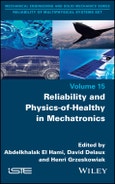This book illustrates simply, but with many details, the state of the art of reliability science, exploring clear reliability disciplines and applications through concrete examples from their industries and from real life, based on industrial experiences.
Many experts believe that reliability is not only a matter of statistics but is a multidisciplinary scientific topic, involving materials, tests, simulations, quality tools, manufacturing, electronics, mechatronics, environmental engineering and Big Data, among others.
For a complex mechatronic system, failure risks have to be identified at an early stage of the design. In the automotive and aeronautic industries, fatigue simulation is used both widely and efficiently. Problems arise from the variability of inputs such as fatigue parameters and life curves. This book aims to discuss probabilistic fatigue and reliability simulation.
To do this, Reliability and Physics-of-Healthy in Mechatronics provides a study on some concepts of a predictive reliability model of microelectronics, with examples from the automotive, aeronautic and space industries, based on entropy and Physics-of-Healthy.
Table of Contents
Preface ix
Abdelkhalak EL HAMI, David DELAUX and Henri GRZESKOWIAK
List of Acronyms xi
Part 1 Entropy and Physics-of-Healthy: Some Concepts to Model Predictive Reliability of Microelectronics for Automotive, Aeronautic and Space Missions 1
Introduction to Part 1 3
Alain BENSOUSSAN, Joseph B. BERNSTEIN and Alain BRAVAIX
Chapter 1 Basic Reliability Tools for SHM Protocols 11
Alain BENSOUSSAN, Joseph B. BERNSTEIN and Alain BRAVAIX
1.1 Introduction 11
1.2 State-of-the-art reliability in DSM and GaN technologies and Physics-of-Healthy: thermodynamics 15
1.2.1 COTS and emerging technologies in deep-sub-micron technologies: short overview 15
1.3 General overview on GaN device failure mechanisms 19
1.4 Physical reliability models applied to DSM technology 24
1.4.1 Precautions associated with accelerated testing 33
1.5 Reliability and probability mathematics 34
1.5.1 Exponential distribution summary 42
1.5.2 Normal distribution summary 42
1.5.3 Weibull distribution summary 42
1.5.4 Lognormal distribution summary 43
1.6 The Sedyakin principle 47
1.7 System reliability 49
1.7.1 Series systems 49
1.7.2 Parallel systems 51
1.7.3 Complex systems 54
1.8 Conclusion and future prospects 58
1.9 References 60
Chapter 2 Applied Engineering on Physics-of-Healthy and SHM of Microelectronic Equipment for Aeronautic, Space, Automotive and Transport Operations 65
Alain BENSOUSSAN, Joseph B. BERNSTEIN and Alain BRAVAIX
2.1 Introduction 65
2.2 Component health monitoring: a case study for automotive and aerospace applications 68
2.2.1 Context and particular issues for automotive applications using emerging technologies 68
2.2.2 Predictive reliability and health monitoring methodology for new technologies 70
2.2.3 Prognostic failure model (PFM) level 3: reliability prediction applied to DSM technologies in harsh environments 80
2.2.4 Reliability study for DD3RL 111
2.3 Aerospace electronics reliability: practical application of MTOL 120
2.3.1 Standard HTOL 122
2.3.2 Multiple mechanisms 123
2.3.3 Acceleration factor 124
2.3.4 Proportionality matrix solution 127
2.4 Conclusion 132
2.5 References 133
Part 2 Failure and Analysis of Systems Engineering 139
Chapter 3 Fault Tree Analysis in the Context of Systems Engineering Design Analysis 141
Felician CAMPEAN and Ed HENSHALL
3.1 Introduction 141
3.1.1 Background to fault tree analysis 142
3.1.2 Functional basis of fault tree analysis 144
3.1.3 Case study: electric bicycle drive system 145
3.2 System-level analysis 146
3.2.1 Function analysis and decomposition 146
3.2.2 System-level function fault tree development 150
3.3 Subsystem-level analysis 152
3.3.1 Subsystem-level function decomposition 152
3.3.2 Subsystem-level function fault tree development 158
3.4 Component-level analysis 160
3.4.1 Component-level function decomposition 160
3.4.2 Component-level function fault tree development 165
3.5 Initial analysis of FFT and further decomposition 167
3.5.1 Analysis of failure events associated with the connecting and branching flows 167
3.5.2 Decomposition of the FFT to a level which facilitates design optimization 170
3.6 eBike drive system function fault tree analysis 174
3.6.1 Macro-level function fault tree analysis 175
3.6.2 Function fault tree analysis based on SSFD heuristics 175
3.6.3 Function fault tree analysis based on cut sets 185
3.6.4 System of systems context for function fault tree analysis 188
3.7 Relationship of FFTA to other engineering tools 191
3.8 Discussion and conclusion 192
3.9 References 195
Chapter 4 Reliability for a Mature Product From the Beginning of Its Useful Life: The Different Types of Tests and Their Impact on Product Reliability 199
Henri GRZESKOWIAK
4.1 Introduction 199
4.2 The product life profile 200
4.3 The product technical specification 201
4.4 The part (or component) engineering 203
4.5 The performance-based requirement in design 207
4.6 The elimination of weakness in design and technologies 208
4.7 Uncertainty and test factors 210
4.7.1 Environment variability 210
4.7.2 Equipment strength variability 210
4.7.3 Aging of equipment 210
4.7.4 The purpose of the uncertainty factor 212
4.7.5 The purpose of the test factor 213
4.8 Validation of the functions 214
4.9 Environmental stress screening and HA-ESS 215
4.10 Conclusion 217
4.11 Appendices 218
4.11.1 Appendix 1: Types of tests 218
4.11.2 Appendix 2: Frequently asked questions on reliability test types 221
4.11.3 Appendix 3: Feasibility test 249
4.11.4 Appendix 4: Comparison of ESS and HA-ESS 252
4.11.5 Appendix 5: Definition of terms 256
4.11.6 Appendix 6: About MTBF calculations based on HALT results 264
4.12 References 265
Chapter 5 Reliability Climatic Test for Composites Based on a Probabilistic Arrhenius Model 267
David DELAUX, Thomas ILLING and Abdelkhalak EL HAMI
5.1 Introduction: needs and constraints of automotive reliability 267
5.2 Proposition of a new probabilistic Arrhenius model 271
5.2.1 Constant Arrhenius model 271
5.2.2 Probabilistic Arrhenius model 273
5.3 Experimental case 283
5.3.1 Assumptions 283
5.3.2 Results 286
5.3.3 Exploration 286
5.3.4 Results and discussions 288
5.4 Conclusion and outlook 289
5.5 References 289
List of Authors 293
Index 295








